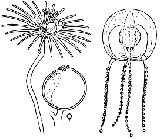
| Intro | | About | | Wiki | | Search traits | | Data explorer | | Literature | | Definitions | | Sources | | Webservices | | Statistics | | Feedback | | Editors | | Log in |
WoRMS taxon detailsTubulariidae Goldfuss, 1818
Hybocodonidae Allman, 1872 · unaccepted (synonym)
Tubulariae Goldfuss, 1818 · unaccepted (old spelling)
Tubulariida · unaccepted (unfounded grouping)
marine, brackish,
Goldfuss, G.A., 1818. Ueber die Classification der Zoophyten. Isis, 1818 : 1008-1013.
page(s): 1010 [details]
Taxonomy The Taxon Tublariidae is usually attributed to Fleming, 1828. However, the name was introduced earlier by Goldfuss (1818)....
Taxonomy The Taxon Tublariidae is usually attributed to Fleming, 1828. However, the name was introduced earlier by Goldfuss (1818). On page 1010 Goldfuss(1818) introduced the taxon (as Tubulariae) and included the genera Tubularia and Sertularia. In the list on page 1012 he then the genus Tubularia is missing in the family Tubulariae, certainly a printing mistake. In Goldfuss (1820), the genus Tubularia is again listed under Tubulariae (the old ending iae in the German text is equivalent to -idae family suffix in current usage). The current usage as Tubulariidae was introduced by Hincks (1868). [details]
WoRMS (2024). Tubulariidae Goldfuss, 1818. Accessed at: https://www.marinespecies.org/aphia.php?p=taxdetails&id=1603 on 2024-08-01
Date action by 2004-12-21 15:54:05Z created db_admin
original description
Goldfuss, G.A., 1818. Ueber die Classification der Zoophyten. Isis, 1818 : 1008-1013.
page(s): 1010 [details] basis of record Bouillon, J.; Boero, F. (2000). Synopsis of the families and genera of the Hydromedusae of the world, with a list of the worldwide species. <i>Thalassia Salent. 24</i>: 47-296 (look up in IMIS) [details]  Present Present  Inaccurate Inaccurate  Introduced: alien Introduced: alien  Containing type locality Containing type locality
From editor or global species database
Diagnosis Hydroid solitary or colonial; hydrocaulus divided into distal neck region covered by thin perisarc, and proximal stem which may be either short and thick with tuber-like aboral processes, or long and cylindrical, or cone-shaped with basal disc, or with stolons covered by thicker perisarc; neck perisarc secreted from a groove on the hydranth proper; hydranth broadly vasiform, tentacles in two sets, oral ones filiform or pseudofiliform in one to several close-set whorls, sometimes capitate or moniliform (especially transiently in juveniles); aboral tentacles long, in one whorl, pseudofiliform or filiform, sitting on a more or less developed parenchymatic cushion of gastrodermal tissue; gonophores develop above aboral tentacles, free medusae or fixed sporosacs; embryonic development without planula but an actinula larvae. Medusae with or without exumbrellar nematocyst tracks, bell margin oblique or straight, radial radial canals; mouth usually circular; gonads covering manubrium entirely; one to four marginal tentacles; with or without asexual medusae budding from marginal bulbs; ocelli absent. [details] Taxonomy The Taxon Tublariidae is usually attributed to Fleming, 1828. However, the name was introduced earlier by Goldfuss (1818). On page 1010 Goldfuss(1818) introduced the taxon (as Tubulariae) and included the genera Tubularia and Sertularia. In the list on page 1012 he then the genus Tubularia is missing in the family Tubulariae, certainly a printing mistake. In Goldfuss (1820), the genus Tubularia is again listed under Tubulariae (the old ending iae in the German text is equivalent to -idae family suffix in current usage). The current usage as Tubulariidae was introduced by Hincks (1868). [details]
|


